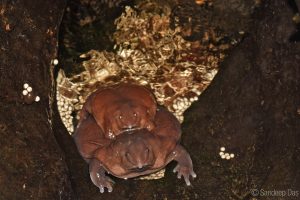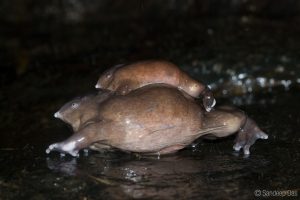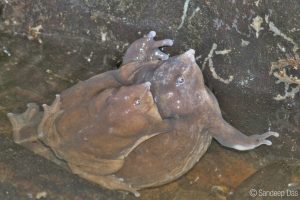
Being a biologist from Kerala in the Western Ghats I am trying to understand and conserve a species of frog that emerges from the underworld only once every year like the great Hindu King Mahabali. This is quite a challenge! The Purple Frog Nasikabatrachus sahyadrensis is the sole member of Nasikabatrachidae, the first new frog family described since 1926. This species has been independently evolving for 130 million years. It is living evidence for the Gondwanaland hypothesis due to its relation to the frogs in the family Sooglossidae that are restricted to the Seychelles archipelago indicating that these land masses were once connected.

Being fossorial (living underground), it took a long time for scientists to understand their ecology. Adult frogs perfectly time their emergence from underground with the early rains when their egg laying sites are inundated by seasonal streams which begin to flow. At the start of these rains, male frogs come close to the surface and begin to call from the underground tunnels. Mating (in frogs this is known as amplexus) happens inside the tunnel and the females, who are double the size of the males, carry the male frogs on their backs to the egg laying sites which are crevices along the fast flowing torrential streams. These bulbous frogs lay their eggs in the crevices.

Soon after the mating and egg laying adult frogs dig down to their underground burrows, the entire process may only take a couple of days; even seeing a frog is therefore a huge challenge. The eggs soon develop into tadpoles with sucker-like mouthparts. These suckers allow the tadpoles to cling onto rocks in fast-flowing currents and they are able to graze undisturbed on algae growing on the rocks covered by torrential water. There are very few frogs that can exploit this seasonal habitat and this is how the tadpoles avoid competition with other aquatic life as well as predators. It takes around 100 to 120 days for the tadpoles to metamorphose (turn into miniature frogs) after which they also go underground.
Very little is known about their life underground or their distributional range. The threats posed to this species have not been studied in detail although the purple frog is considered Endangered. Some of the threats reported include consumption of the tadpoles by an indigenous community and the construction of check dams to control water flow which submerges their breeding sites.
As an EDGE Fellow I will spend the next two working towards understanding the conservation needs of the purple frog by integrating conservation research and awareness programs in order to support and inform desirable management processes and involve communities in the conservation of this Endangered and endemic frog.
– Sandeep Das